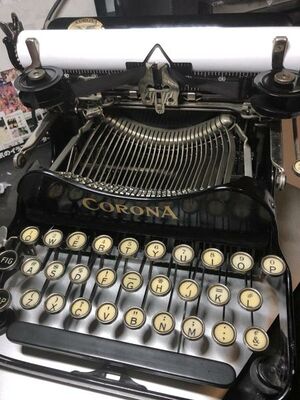Smith-Corona
Smith-Corona, also known as Standard Folding, Corona Typewriter Co., L. C. Smith and Brothers, L. C. Smith and Corona, and Smith-Corona Marchant, was and is one of the most illustrious typewriter companies to exist.
Contents
History
As Standard Folding
In 1906, the Standard Folding Type-Bar Typewriter Co. is established. Engineer Frank Rose created a folding machine that would fold in half, making it a truly portable machine to compete with the one other lightweight model on the market: the Blickensderfer. Having typebars and a more conventional layout, the design had potential. Some 12 000 Standard Foldings were made, and they are a rather rare and desirable machine today. Eventually, the Standard Folding would be rebranded into one of the most popular machines to ever have existed, the Corona 3.
As Corona
In 1909, the Standard Folding company was acquired by an investor and moved to Groton, N.Y. In 1912, after a variety of edits had been made to the basic Standard Folding design, it was redesigned and marketed as the Corona 3. This new machine saw great success. A variant, the "3 Special", was introduced in the early 1920s; it featured right-hand shift keys and came in colors like red, blue, and green, or gold inlays on black. [1]
Eventually, the folding 3-bank Coronas were superseded by the Corona 4, a slightly larger machine retaining the distinctive curves of the 3, but adopting a 4-bank standard keyboard. The 3 remained in production until 1941, however, outlasting the 4.
L.C. Smith and Bros.
As the Corona typewriter company was rapidly growing, L.C. Smith and Brothers had been making standard office typewriters. Due to legal issues, the former inventors of the Smith Premier had started a new company, and created a new standard that used ball-bearings in the type arms, rather than a conventional segment. Based out of Syracuse, N.Y., the L.C. Smith was a very popular standard and continued to be produced after the L.C. Smith and Corona merger.
As Smith-Corona
In 1925, L.C. Smith and Bros. merged with the Corona Typewriter Co. to create Smith-Corona, formally L. C. Smith and Corona Typewriters Inc. Under the new name, the company launched a new line of midsized portables, the 1 series, commonly colloquially under the moniker "Flattop". All new products were advertised under the Smith-Corona name. Marchant Calculators merged with Smith-Corona in 1958 to create Smith-Corona Marchant, commonly abbreviated SCM. This typewriter powerhouse still exists to this day as a manufacturer of printing machines, as well as related office products.
Smith-Corona Typewriters
Portables
| Name | Date Range | Description & Rarity |
|---|---|---|
| Standard Folding 1 & 2 | 1904-1912 | Small, silver, and rather rare. |
| Corona 3 | 1912-1941 | The improved version of the Standard Folding, rather common. |
| Corona 4 | 1924-1941 | A New Design for a New Decade, somewhat uncommon. |
| Smith Corona "Flattop" | 1931-1938 | Nicknamed flattops for their large flat ribbon covers, these machines are not very rare but are very sought after. |
| Smith Corona Speedline | 1938-1949 | The most generic type of Smith Corona portable out there. Crinkle black with white decals. More common than dirt. |
| Smith Corona 5 Series | 1949-1960 | Smith Corona Speedlines but with different shells and new plastic parts. Also rather common. |
| Smith Corona 6 Series | 1960-1980 | Also known as the "Galaxie" for their first model, these are the most recent and most common. Widely introduced 12" Platens and electric portables into their lineups, and the last line to feature predominantly metal bodies. Typically known for its tell-tale "sliding" ribbon cover. |
Standards
Ultraportables
| Name | Date Range | Description & Rarity |
|---|---|---|
| Zephyr | 1938-1941 | Thin, "spam-tin" like opening case-topper with round, black plastic keys. Note all SCM ultraportables use smaller than universal spool diameters. Harder to find (Zephyr and the Spools). |
| Skyriter | 1949-1960 | Continuation of the Zephyr design with a hinged ribbon cover. Some later models forwent the reduced return lever and metal case topper for a softer case and longer return lever. Decently common. |
| Corsair | 1964-1977 | Plastic body line of typewriters with many color, many re-badges, and many names, with internals based on Skyriter. Created to compete with Japanese Ultra portables in the market (like Brother). Included features earlier SCM Ultraportables lacked, such as ribbon color selectors and pre-set tabs. Extremely common, but repairs are an extreme hassle. |
